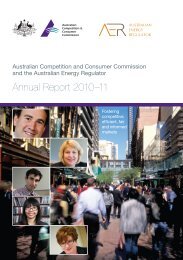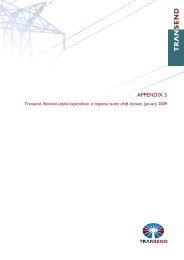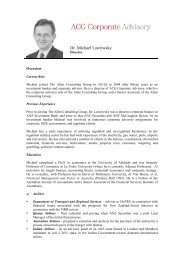Internal consistency of risk free rate and MRP in the CAPM
Internal consistency of risk free rate and MRP in the CAPM
Internal consistency of risk free rate and MRP in the CAPM
Create successful ePaper yourself
Turn your PDF publications into a flip-book with our unique Google optimized e-Paper software.
<strong>the</strong> cost <strong>of</strong> equity directly (ie, <strong>the</strong> cost <strong>of</strong> equity that would result from application <strong>of</strong> <strong>the</strong><br />
<strong>CAPM</strong> if we could accu<strong>rate</strong>ly estimate each parameter sepa<strong>rate</strong>ly). 52 .<br />
155. The downside <strong>of</strong> <strong>the</strong> first methodology is that it is only possible if <strong>the</strong>re is listed equity<br />
with comparable <strong>risk</strong> to <strong>the</strong> reference services <strong>and</strong> <strong>the</strong>re is some methodology for<br />
arriv<strong>in</strong>g at an estimate <strong>of</strong> <strong>the</strong> future dividends that <strong>in</strong>vestors expect that equity to pay.<br />
In <strong>the</strong> US, regulators rely <strong>in</strong> part on a relatively deep pool <strong>of</strong> analyst forecasts for this<br />
purpose. Arguably, <strong>the</strong> level <strong>of</strong> analyst coverage for <strong>in</strong>dividual regulated bus<strong>in</strong>esses,<br />
<strong>and</strong> certa<strong>in</strong>ly <strong>the</strong> pool <strong>of</strong> regulated bus<strong>in</strong>esses, is not as deep <strong>in</strong> Australia as <strong>in</strong> <strong>the</strong> US.<br />
156. Of course, hav<strong>in</strong>g regard to comparables <strong>in</strong> o<strong>the</strong>r countries, such as <strong>the</strong> US regulated<br />
bus<strong>in</strong>esses <strong>and</strong> US regulatory determ<strong>in</strong>ations, is one way to address any perceived<br />
lack <strong>of</strong> depth <strong>in</strong> Australian data.<br />
157. A fur<strong>the</strong>r potential objection to this approach is that <strong>the</strong> estimates <strong>of</strong> <strong>the</strong> cost <strong>of</strong> equity<br />
are sensitive to <strong>the</strong> level <strong>of</strong> stock prices at <strong>the</strong> time that <strong>the</strong> estimate is made. The<br />
volatility <strong>in</strong> equity prices (relative to long run dividend forecasts) means that <strong>the</strong> DGM<br />
estimate <strong>of</strong> <strong>the</strong> cost <strong>of</strong> equity will also be volatile.<br />
158. Once more, this can reasonably be argued to be a ‘feature’ ra<strong>the</strong>r than a ‘bug’ to <strong>the</strong><br />
extent that <strong>the</strong> volatility <strong>in</strong> equity prices is driven by volatility <strong>in</strong> prevail<strong>in</strong>g conditions <strong>in</strong><br />
equity markets (ie, volatility <strong>in</strong> equity <strong>in</strong>vestor’s required return on equity). However, at<br />
least part <strong>of</strong> <strong>the</strong> volatility <strong>in</strong> equity prices is likely to be driven by illiquidity <strong>in</strong> <strong>the</strong> market<br />
for a particular equity. Consequently, part <strong>of</strong> <strong>the</strong> volatility <strong>in</strong> DGM estimates may<br />
simply reflect movements driven by lopsided buy or sell side activity. However, this<br />
can potentially be addressed by us<strong>in</strong>g a longer average <strong>of</strong> equity prices (e.g.<br />
measured over a month or several months).<br />
7.1.1. Application<br />
159. I have used <strong>the</strong> dividend growth model to forecast a cost <strong>of</strong> equity for Australian<br />
regulated utilities <strong>of</strong> between 10.87% <strong>and</strong> 14.59%. This is based on analyst dividend<br />
forecasts sourced from Bloomberg on 24 February 2012 <strong>and</strong> 9 March 2012 <strong>and</strong> <strong>the</strong><br />
average price <strong>of</strong> equities for <strong>the</strong>se firms over <strong>the</strong> period 24 February 2012 to 9 March<br />
2012. The range for <strong>the</strong> cost <strong>of</strong> equity is based on a range for long term dividend<br />
growth from zero growth <strong>in</strong> real terms (2.5% nom<strong>in</strong>al) to growth <strong>in</strong> l<strong>in</strong>e with long term<br />
average GDP growth (6.6% nom<strong>in</strong>al).<br />
7.2. Methodology ii)<br />
160. As with <strong>the</strong> first methodology, <strong>the</strong> second methodology relies on a DGM estimate <strong>of</strong><br />
prevail<strong>in</strong>g returns but <strong>in</strong>stead <strong>of</strong> be<strong>in</strong>g only for comparable firms <strong>the</strong> DGM is applied to<br />
<strong>the</strong> market as a whole. However, one still needs to sepa<strong>rate</strong>ly analyse comparable<br />
52 Note that if <strong>the</strong> <strong>CAPM</strong> actually describes how <strong>in</strong>vestors arrive at required returns <strong>the</strong>n a well implemented DGM analysis<br />
will estimate <strong>the</strong> <strong>CAPM</strong> cost <strong>of</strong> capital <strong>in</strong> <strong>the</strong> market place. If <strong>the</strong> <strong>CAPM</strong> does not describe how <strong>in</strong>vestors assess <strong>risk</strong> <strong>the</strong>n<br />
this will not be <strong>the</strong> case. Of course, that is a ano<strong>the</strong>r ‘feature’ <strong>of</strong> <strong>the</strong> DGM ra<strong>the</strong>r than a ‘bug’.<br />
Competition Economists Group<br />
www.CEG-AP.COM<br />
43







